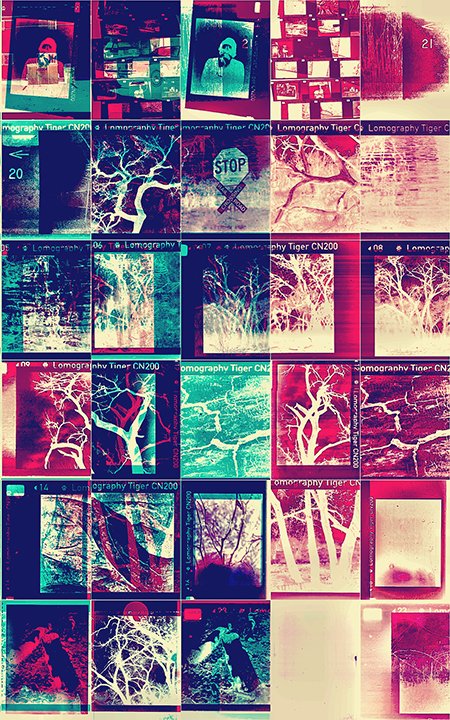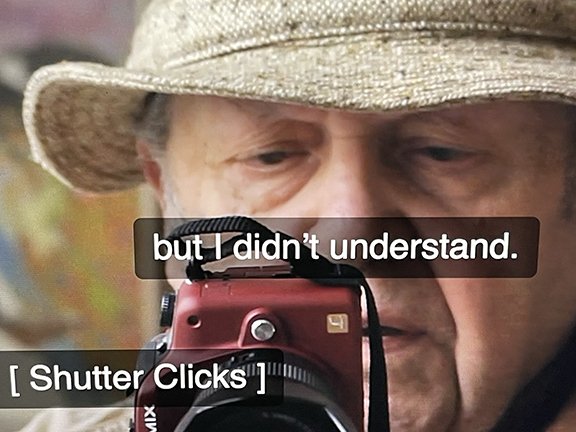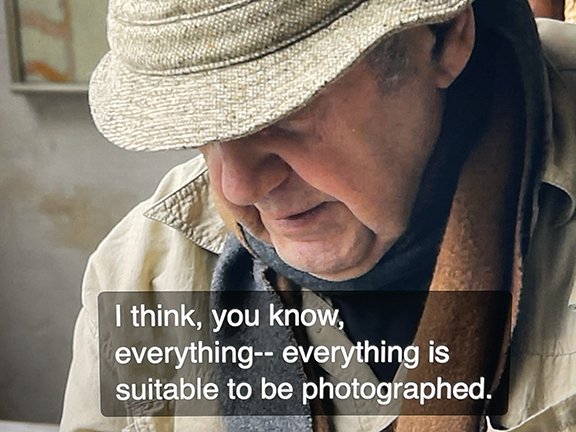2022: 4 Re-visiting old work
Taking a knife to work from decades ago. It has been at turns liberating, frustrating, violent, and ultimately…rewarding.
“Any Day Now” by Elbow
What's got into me
Can't believe myself
Must be someone else
Must beAny day now how's about getting out of this place
Anyways
Got a lot of spare time
Some of my youth and all of my senses on overdriveDon't play Coltrane you will sleep at the wheel
Eyes on horizon
Don't sleep at the wheel
110 Film Blues (and reds)
Old, nearly dead, film formats bring their own challenges to the table. But I won’t let a tiny negative get in my way of having fun.
2022: 3
Somewhere in Kansas.
A masterpiece of the unspectacular.
2022: 2
2022
New year, same me.
2022: 1
2021:50 Koudelka Shooting Holy Land
There is no shortage of videos on YouTube that feature photographers out in the world, taking pictures. Many…too many… feature young, hipsters shooting film. These videos are one of the reasons that the aftermarket for old, analogue cameras has exploded over the past few years. What was once old equipment that no one wanted is now commanding ridiculous prices on Ebay. If there is a new YouTube video released featuring an up-until-then obscure camera, the price immediately starts creeping up. But the curmudgeon in me has to also tip my hat to these neophytes, since they are truly the ones keeping film photography off of life support.
I prefer my vicarious photo shooting viewing to be centered on masters of the medium. There is one film in particular that I’ve been wanting to see for some time. The movie is called Koudelka Shooting Holy Land. I’ve been waiting to see if it would pop up somewhere for free, but alas, I finally caved and dropped 10 bucks to stream it at home. Was it worth it? Absolutely. It is an often quiet meditation on the challenges of finding inspiring subject matter, and approaching it with a critical, yet compassionate eye. Koudelka shot the areas in Israel that are the meeting points between Palestinian lands and Jewish settlements. The photos resulted in an amazing book from a few years back that I’ve written about previously, titled Wall. It was a joy to watch him wander through environments that at one turn were mundane, and at another, quite tense. Koudelka navigates it all with a world weary resignation that I found charming and inspiring.
Some of the most compelling moments in the film occur when Koudelka navigates the hyper-security measures in place at border crossings and checkpoints. For a photographer who first came to prominence documenting the Soviet invasion of his native Czechoslovakia in 1968, he is no stranger to working in challenging situations. Yet most of Koudelka’s interactions with the authorities amount to mostly gruff but docile harassment from military people who are more concerned with threats of violence and not an old man with a panoramic camera. Still, hearing a voice shout from a watchtower as he sets up a few of his shots is enough to give me concern for his safety. Yet Koudelka slowly, deliberately continues his work, unfazed and unintimidated by the powers that keep watch over a complicated mix of politics and differences in faith, all while adding to the tension and division that the photographer himself is quietly, critically assessing. If you get the chance, spend the 10 dollars and watch a master at work.
2021: 49 Fear and Loathing on Ebay
The life of a film photographer is sometimes an emotional minefield. The thrill of the “shoot and wait to see” process is often offset by soul crushing disappointment. Cameras are mis-loaded, film is exposed improperly, chemicals are exhausted… dust and scratches and fog, oh my. Add to the rollercoaster ride of emotions the pursuit of a working film camera. Sifting through Craigslist, thrift stores, yard sales and Ebay is a common pastime for film geeks. I experienced a bit of the bad end of the pursuit recently, and I’m still kinda pissed about it.
Why did I need to buy a 110 film camera? The bane of my existence in 7th grade, a shitty format that now seems so quaint and enticing. Fuck you, nostalgia. Lomography are like camera and film drug dealers to me. They are the only place to buy new 110 film cartridges. I bought a few rolls recently, not even owning a camera to shoot them with. So I jump on to Ebay, and hunt down a sporty, sexy old Minolta SLR zoom 110 camera. Yeah… a Rolls Royce of the tiny format. The camera looked good, was sold “as-is” but at a decent price. I rolled the dice. Of course, the anticipation of tracking a package from UPS is part of the thrill of buying something online. A 50 year old camera inching closer to my grubby hands. Of course, it arrived days after it was scheduled to be delivered. Of course, I opened the package immediately and popped batteries in and pressed the shutter. A weak, painfully slow reaction happened inside the camera…eventually I heard a faint click. No warning lights, no view to be seen through the viewfinder. Then…nothing. Nothing. In short, a lemon. A paperweight.
I decided since it wasn’t working anyway, I’d try to take it apart and fix it. Small, Phillips head screws held the body together. Simple to open up and poke around. Except that I am not at all mechanically inclined. My ten thumbs quickly dismantled the camera with no fucking way for me to even think of fixing it; never mind trying to put it all back together. In a fit of frustration, I threw the camera on the ground, where it burst into multiple pieces. I swept up the debris and threw it all in the dumpster. Case closed.
This is not the first time I threw money out the window on a non-functioning camera. My success rate is slightly over 50%, if I’m being honest. This one stung more than others though. Why? Was it that I bought into the hype over a format that was inferior when it first came out, swapping image quality for ease of loading and shooting? I scoffed when I heard Lomo was coming out with 110 film. And yet…and yet. So what do you do when you get burned by defeat? Do you walk home with your tail between your legs? Do you go home and cuddle with your Canon 6D, 23 megapixel lover who won’t break your heart? Or do you double down and fight against all odds to snatch victory from the jaws of 50 year old, dormant technology?
My new Minolta 110 slr zoom camera arrives in about a week.
2021: 48 Saul Leiter
I watched “In No Great Hurry: 13 Lessons in Life With Saul Leiter,” by the British filmmaker Tomas Leach this week. It is a wonderful film, at times amusing and at times very sad. The idea that a master photographer can live a quiet life in New York City should be comforting, I suppose. But I also was struck by seeing an aging, lonely Leiter sifting through the detritus of his life, and my heart hurt when I realized that here was a great artist, living…not so much in obscurity, but in anonymity. Saul Leiter, who died in 2013, brought color to a genre that was deeply entrenched in monochrome in the 1950s. His eye gravitated towards subtle abstraction, which I find curious, considering the chaos and complexity of the “real world” on display in the streets of New York. Maybe the fact that Leiter was also a painter has something to do with this.
Those of us deeply immersed in the world of photography probably hold our “heroes” in high regard, and we expect them to perhaps live a life that we might envy. Yet watching Leiter sitting alone, surrounded by his life work, stacked in old film boxes and gathering dust, it made me wonder what becomes of the even less recognized artists out there. What becomes of all the work they (and I) create through their lives? Maybe never destined for a book or a museum show, but instead sitting in piles in an office or studio. What treasures will go undiscovered, or under appreciated?
2021:47 In Purgatory
A quiet, long holiday weekend in the mountains of Colorado. Quiet, cold, some snow. A hot tub and sauna and plenty of attitude adjusters. Purgatory isn’t so bad, when caught between heaven and hell.
2021: 45 Proof
Thanks to my ongoing obsession with Austin Kleon, I purchased a rubber stamp this week. My idea was to get something I could use to mark my working photos. Especially since my Japan photo book completely sold out this week, I wanted to try to reappropriate the proof prints in some way. I went to a local shop near my studio, and the next day I had my “PROOF” rubber stamp.
It’s a curious word, proof. Photographers or printers use it to denote a working version of a print; something not intended to be the final work to be seen, shared or sold. However, the word also has there, nicer, broader meanings and uses. Evidence for one. A photo, in many ways, is proof, isn’t it? Evidence that I was somewhere, I saw this thing, and I documented it photographically, thus providing proof of… what? It’s existence? My existence? All of this and more?
I then started to think about proof in an even broader sense. The rubber stamp could be used to validate, to empower, to prop up, to sway a viewer. The bold red ink, the all caps san serif typeface, set in 42pt Helvetica Bold; it’s screams of validation. Of existence. PROOF.
I think I’ll be using this stamp much more than I originally intended.
Sage words from Dante.
















